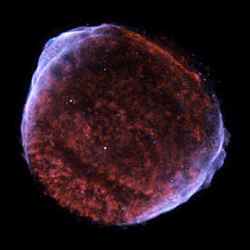
SN 1006. Image credit: NASA. Click to enlarge
This false-color Chandra image of a supernova remnant shows X-rays produced by high-energy particles (blue) and multimillion degree gas (red/green). In 1006 AD, what was thought to be a “new star” suddenly appeared in the sky and over the course of a few days became brighter than the planet Venus. The supernova of 1006, or SN 1006, may have been the brightest supernova on record.
We now know that SN 1006 heralded not the appearance of a new star, but the cataclysmic death of an old one located about 7,000 light years from Earth. It was likely a white dwarf star that had been pulling matter off an orbiting companion star. When the white dwarf mass exceeded the stability limit (known as the Chandrasekhar limit), it exploded.
The supernova ejected material at millions of miles per hour, generating a forward shock wave that raced ahead of the ejecta. Particles accelerated to extremely high energies by this shock wave produce the bright blue filaments seen in the upper left and lower right of the image. Why the bright filaments occur only in the observed locations and do not encircle the remnant is not understood. One possibility is that they are due to the orientation of the interstellar magnetic field which may be roughly perpendicular to the filaments.
High pressure behind the forward shock wave pushes back on the supernova ejecta, causing a reverse shock that heats the ejecta to millions of degrees. The fluffy red features seen throughout the interior of the remnant are from gas heated by the reverse shock. The X-ray spectrum of this gas indicates that it is enriched in oxygen and other elements synthesized by nuclear reactions during the stellar explosion.
Original Source: Chandra X-Ray Observatory
